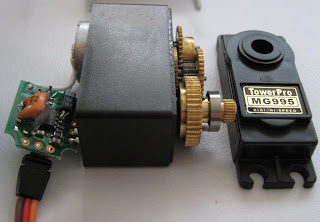
LEDs are a flashing. How exciting! Nothing gets a hardware engineer going like a couple of flashing LEDs. It symbolises success. Half the battle is won when you can program a piece of hardware to flash some LEDs. It means that you:
- Soldered the major components correctly,
- Have a working power supply,
- Have a tool chain for compiling programs for the hardware,
- Have a method for downloading the code to the hardware.
So I removed the 8MHz resonator connected to pins 2 and 3, not needed since the PIC has an internal RC oscillator. I soldered two LED resistor pairs between ground and pins 2 and 3 respectively. I then grabbed some assembly code from this site, and modified it to output to the two LEDs alternately. It is listed here:
; An LED Blinker
list p=12f675
include "p12f675.inc"
__CONFIG _CPD_OFF & _CP_OFF & _BODEN_OFF & _MCLRE_OFF &_PWRTE_OFF & _WDT_OFF & _INTRC_OSC_NOCLKOUT
small_delay_tmp equ 0x20
long_delay_tmp equ 0x21
goto main
small_delay:
movlw 0xff
movwf small_delay_tmp
small_delay_L1:
decfsz small_delay_tmp, F
goto small_delay_L1
return
; ----------------------------
; W contains count on entry.
; Store it in a temp variable.
; Keep on decrementing and
; calling small_delay
; ----------------------------
long_delay:
movwf long_delay_tmp
long_delay_L1:
call small_delay
decfsz long_delay_tmp, F
goto long_delay_L1
return
; ----------------------------
; The main LED blinker
; ----------------------------
main:
bcf STATUS, RP0
clrf GPIO
movlw 0x7
movwf CMCON ; disable comparator
bsf STATUS, RP0
movlw 0x0
movwf TRISIO ; All pins outputs
bcf STATUS, RP0
infinite:
bcf GPIO, GP5
bsf GPIO, GP4
movlw 0xFF
call long_delay
bsf GPIO, GP5
bcf GPIO, GP4
movlw 0xFF
call long_delay
goto infinite
end
list p=12f675
include "p12f675.inc"
__CONFIG _CPD_OFF & _CP_OFF & _BODEN_OFF & _MCLRE_OFF &_PWRTE_OFF & _WDT_OFF & _INTRC_OSC_NOCLKOUT
small_delay_tmp equ 0x20
long_delay_tmp equ 0x21
goto main
small_delay:
movlw 0xff
movwf small_delay_tmp
small_delay_L1:
decfsz small_delay_tmp, F
goto small_delay_L1
return
; ----------------------------
; W contains count on entry.
; Store it in a temp variable.
; Keep on decrementing and
; calling small_delay
; ----------------------------
long_delay:
movwf long_delay_tmp
long_delay_L1:
call small_delay
decfsz long_delay_tmp, F
goto long_delay_L1
return
; ----------------------------
; The main LED blinker
; ----------------------------
main:
bcf STATUS, RP0
clrf GPIO
movlw 0x7
movwf CMCON ; disable comparator
bsf STATUS, RP0
movlw 0x0
movwf TRISIO ; All pins outputs
bcf STATUS, RP0
infinite:
bcf GPIO, GP5
bsf GPIO, GP4
movlw 0xFF
call long_delay
bsf GPIO, GP5
bcf GPIO, GP4
movlw 0xFF
call long_delay
goto infinite
end
I assembled it through piklab with gpasm from gputils. I then downloaded it through the ICD2 programmer again using piklab, configured so that the board is powered through the ICD2 (it doesn't seem to work otherwise). Amazingly the LED's flash, just like they are supposed to. Yay.
I'm not a fan of programming in assembler, so I'm going to try a couple of C compilers like SDCC. Unfortunately the PIC12F675 has only 1 kwords (1 word = 14 bits = 1 opcode) of program space, so to getting a C program to fit maybe a challenge. But why not try.
I'm not a fan of programming in assembler, so I'm going to try a couple of C compilers like SDCC. Unfortunately the PIC12F675 has only 1 kwords (1 word = 14 bits = 1 opcode) of program space, so to getting a C program to fit maybe a challenge. But why not try.
